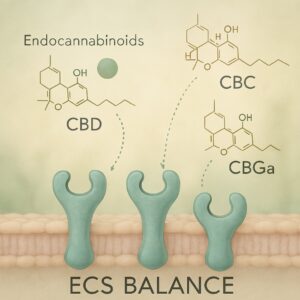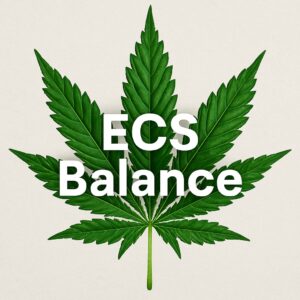Views: 0
Summary
The 2000 study "Endocannabinoids and Fatty Acid Amides in Cancer, Inflammation and Related Disorders" revealed that our body's natural cannabinoids fight cancer, inflammation, and more. Today, balancing the ECS with cannabinoids like CBGa, CBDa, and THC remains key to true, natural healing.

In November 2000, a study titled “Endocannabinoids and Fatty Acid Amides in Cancer, Inflammation and Related Disorders” showed that the natural compounds made inside us — called endocannabinoids — play a critical role not just in regulating mood and pain but also in fighting cancer, inflammation, wasting syndromes, and more. This research looked at Anandamide (AEA), 2-AG, and a few other fatty acid derivatives that mimic cannabis compounds inside the body and suggested a future where these molecules could become real medicine.
Fast-forward to today, and it’s clear: the Endocannabinoid System (ECS) isn’t just about feeling good—it’s about surviving and thriving. It’s about balance, healing, and resilience. It’s about the raw, gritty power of our biology working in sync with the world.
Why I Still Love THC
I tell a lot of people — don’t mistake my deep love for cannabinoids like CBGa, CBDa, and all the “minors” that spark the ECS into action as some disrespect for THC. THC was my first love—forty-plus years of uninterrupted appreciation. I’ve done it all by rolling joints, packing bowls, and dabbing the strong stuff.
But being a lover of all cannabinoids means respecting the symphony, not just one soloist. THC led me into this world. But it was CBGa, CBD, CBN, and the entire crew of minor cannabinoids that showed me how the body finds balance — how we create a true wave of healing instead of just a flash of euphoria.
How Cannabinoids Create a Symphony in the Body
This isn’t just theory—it’s science. The 2000 study detailed how endocannabinoids like Anandamide and 2-AG don’t just “float around” doing nothing—they land on CB1 and CB2 receptors and trigger real changes—changes in pain response, changes in inflammation, changes even at the DNA level in cancer cells.
Meanwhile, fatty acid derivatives like PEA and Oleamide — while not technically classical endocannabinoids — still interact with this system and many do consider them to be one, they’re responsible for modulating immune function, sleep, mood, and repair.

These compounds don’t get you “high,” but they heal you; we get them from food, so how we live matters. We have over 90 other known of fatty amides in our body potentially, depending on how we treat ourselves. Most of us are unaware these are responsible for literally creating our personalities, or rather heavily influence how we interact with others, fatty amides in research have been implicated in almost every receptor system meaning we see, hear, taste, desire different foods, like different movies, all of this based on the ‘balance’ of them.

Riding the Waves: How I Use Cannabinoids for Balance
Over the years, I’ve learned that you can’t just pump yourself full of one cannabinoid and expect everything to work forever. That’s not how the ECS operates. It’s an orchestra — it needs different notes. By using a variety of cannabinoids — CBGa, CBDa, CBG, CBD, and yes, THC — I create waves of activity that ripple across my ECS. Some cannabinoids upregulate the system, causing more receptors to circulate.
Others calm it down, refreshing and resetting the tone. It’s a constant cycle, so my endocannabinoid levels — especially Anandamide (AEA) — stay dynamic even after tough times. When I feel depleted, I don’t panic. I stack the deck with plant compounds that help rebuild what life and stress have torn down.
Endocannabinoids: The Unsung Heroes of Health
That 2000 study hammered home something critical many overlook: the body’s cannabinoids are real medicine. Anandamide and 2-AG aren’t side characters. They are center stage in fighting tumors, cooling inflammation, regulating metabolism, preventing cachexia, and easing chronic pain.
But they need help. They need circulation. They need receptors to land on. And cannabinoids from the plant — particularly the raw forms like CBGa and CBDa — offer building blocks and stimulation to keep that internal system moving.
The Mind on Endocannabinoids
It’s not just about physical healing. Those “tiny little particles” — those endocannabinoids and related compounds — float through the brain, shaping mood, memory, intuition, and clarity. When the ECS is thriving, your mind feels like an open, flowing river.
When it’s out of balance, everything becomes murky, tight, overthought, and hesitant.
And that’s where people get stuck. They overthink their healing journey, doubting the systems designed to guide them. They hesitate, and that hesitation costs them vitality.
Cannabis as Medicine — and Fun
Let’s be real: Cannabis has been the people’s medicine long before doctors decided to get involved. It was never about clinical trials at first. It was about lighting up, passing it around, easing burdens, and feeling good.
I don’t like having to call that “getting medicated” and not getting stoned or society’s desire to have us rebrand ourselves as no longer stoners even when we are successful. It’s like trying to rebrand our connection to the plant. It’s medicine and joy, healing and fun. It’s not either-or—it’s the whole experience.
And now we’ve discovered so much more.
Slowly, the world is catching on, and learning about balancing the Endocannabinoid System instead of taking Tolerance or T-Breaks.
A Return to Simplicity
The 2000 research study didn’t suggest some synthetic overhaul of our bodies. It meant that what we already have — and what plants like cannabis offer — is powerful enough if we work with it. The answer isn’t some lab-made analog. It’s trusting the relationship that humans and Cannabis have had for thousands of years.
Plant compounds modulate the ECS naturally. They bring balance without forcing it, letting the body remember how to be well.
The Real Revolution: Balance, Not Overload
At the Global Cannabinoid Research Center, we don’t study the synthetic THC analogs flooding the hemp market these days. That’s not the path to proper balance – it’s the exact opposite. Real healing comes from nurturing the original system with the right compounds at the right times for the right reasons. It’s about supporting what nature has already built inside us, not trying to outsmart it with quick fixes.
Final Thoughts: Trust the Plant, Trust the Process
Everything we need is already built into and around us. Endocannabinoids, fatty acid amides, CBGa, CBDa, THC, and the plant itself are all threads in the same fabric.
You don’t need to overthink it. You need to trust it.
Trust nature, trust your ECS, and Trust that your body was designed to heal; our lifestyle and diet can provide the essential elements necessary. Cannabis has been answering humanity’s calls for comfort, clarity, and healing long before the was an industry or market.
And it’ll keep doing that — if we let it.
ECS Balance is key. ©Mike Robinson, The Researcher, Founder of Genevieve’s Dream

(Reprints of our blog are allowed with proper linkback to this website)
Reference:
Luciano De Petrocellis, Dominique Melck, Tiziana Bisogno, Vincenzo Di Marzo,
Endocannabinoids and fatty acid amides in cancer, inflammation and related disorders,
Chemistry and Physics of Lipids, Volume 108, Issues 1–2, 2000,
Pages 191-209, ISSN 0009-3084, https://doi.org/10.1016/S0009-3084(00)00196-1.



